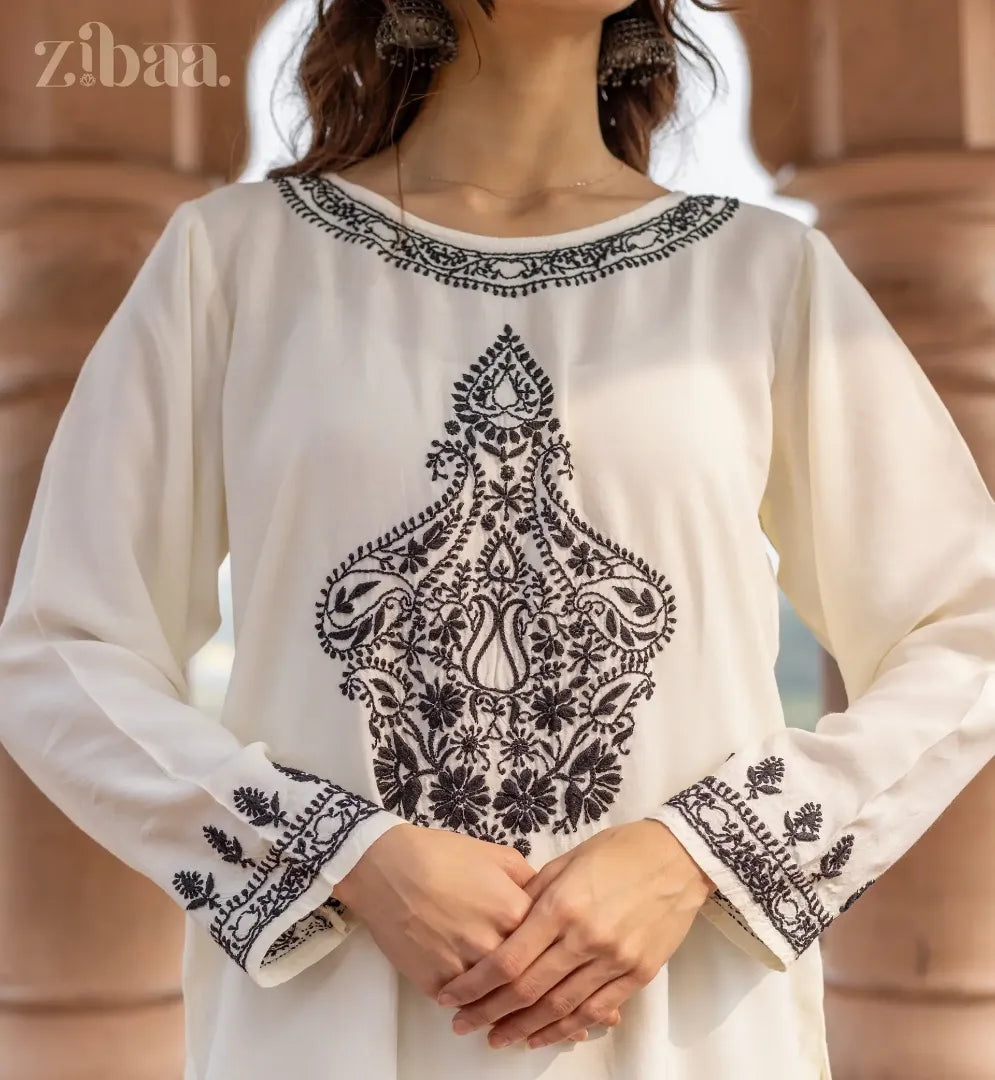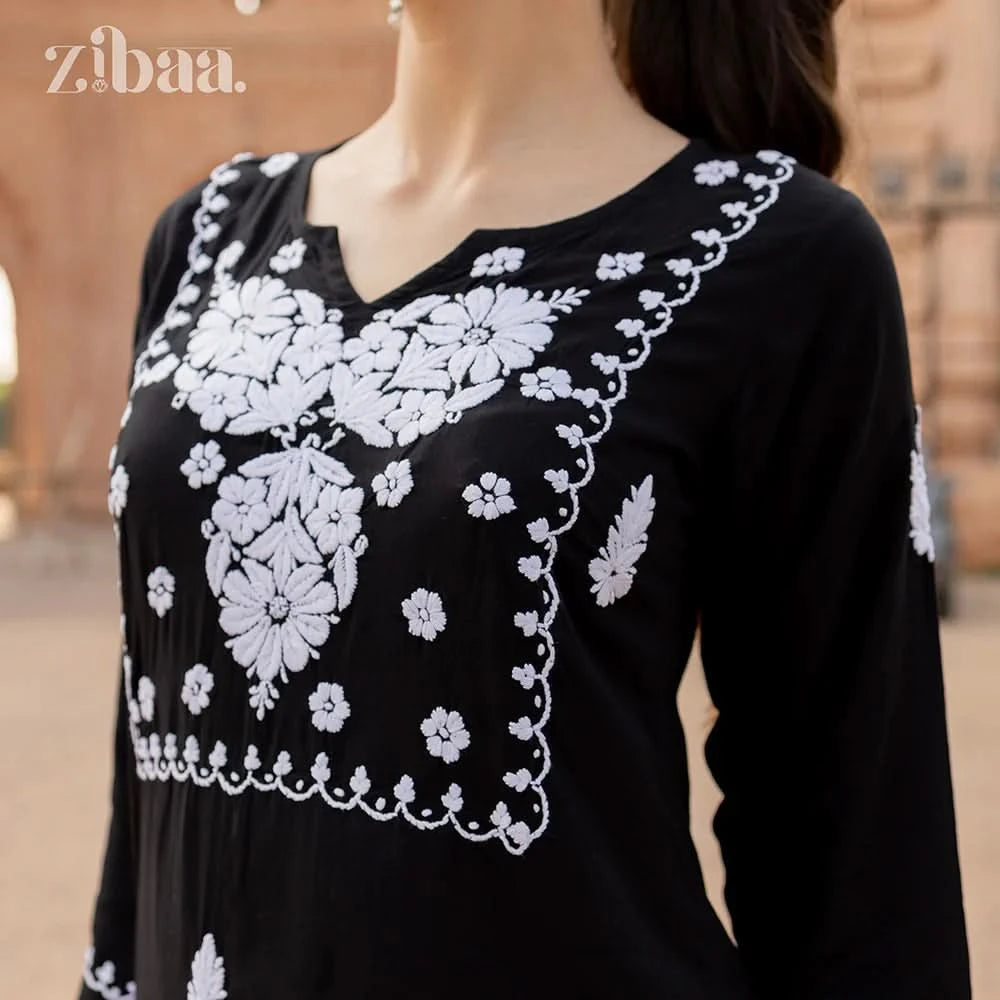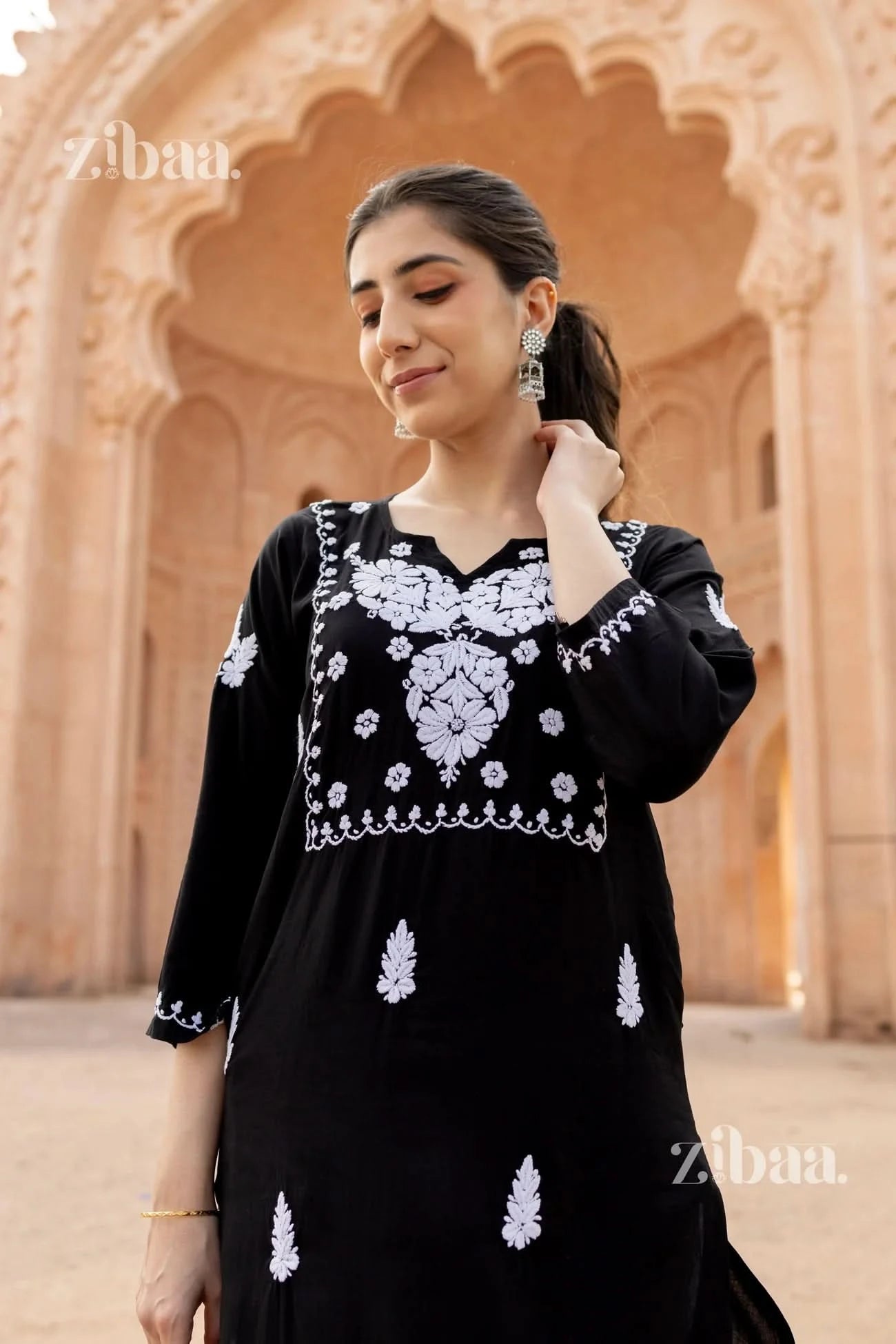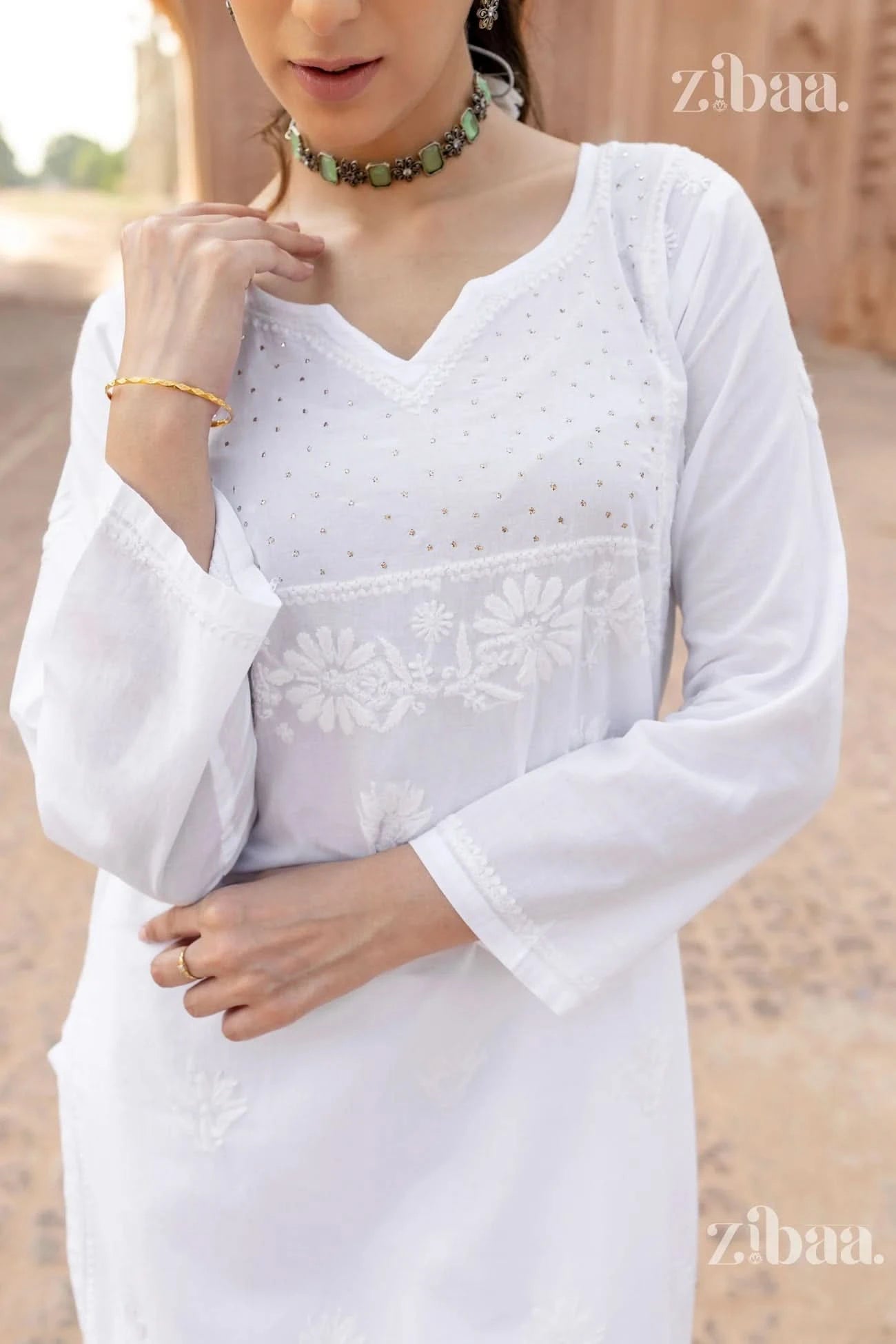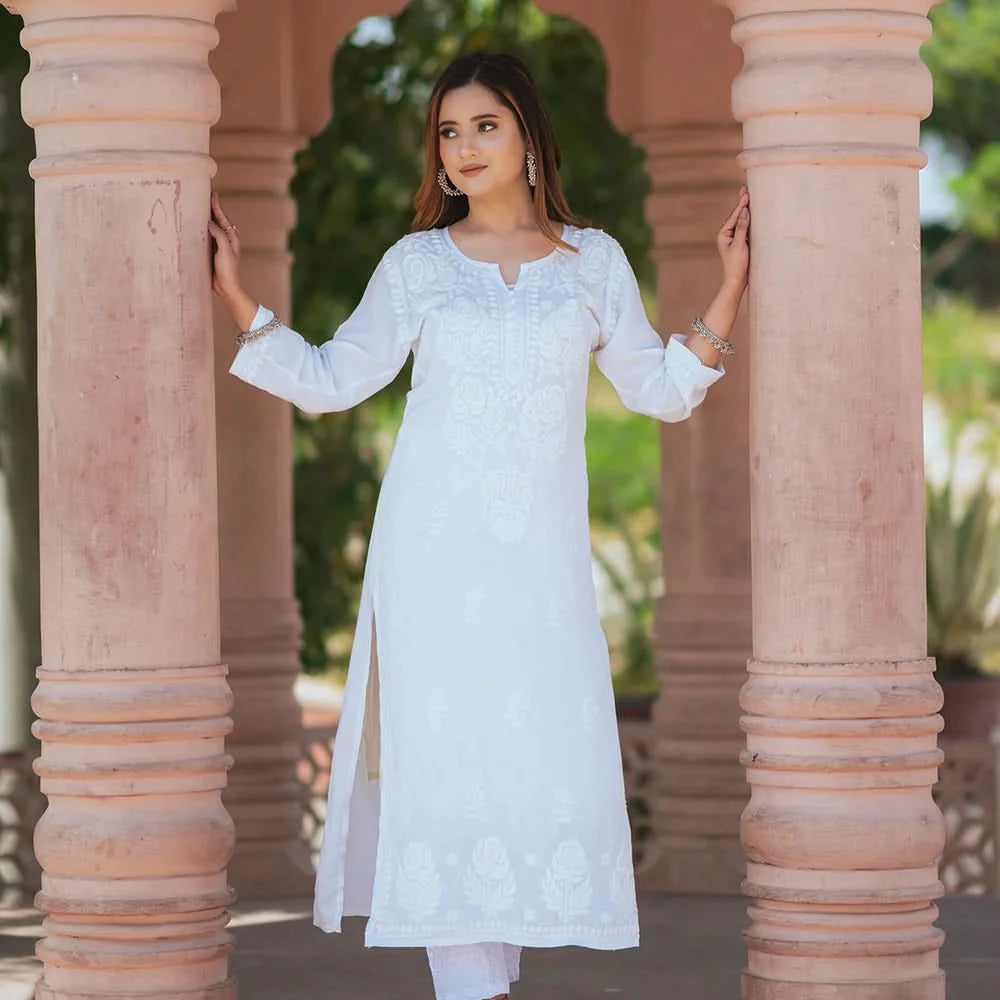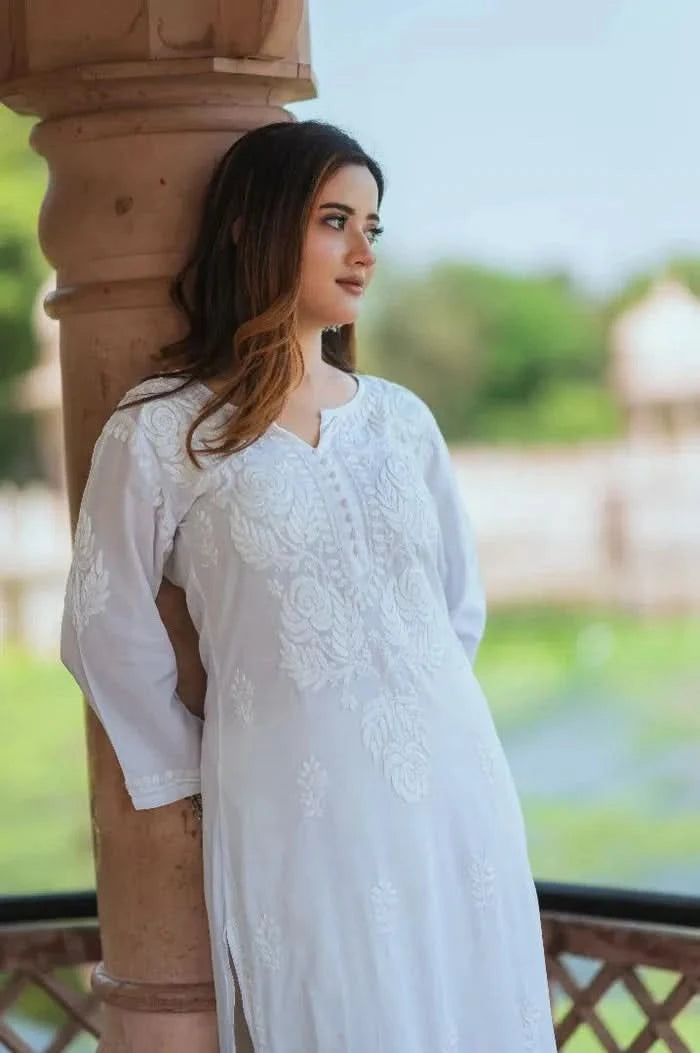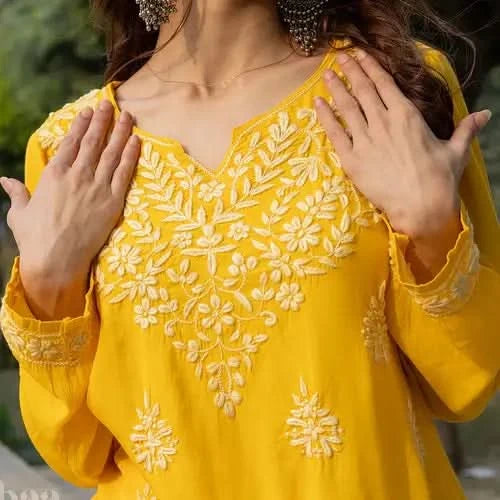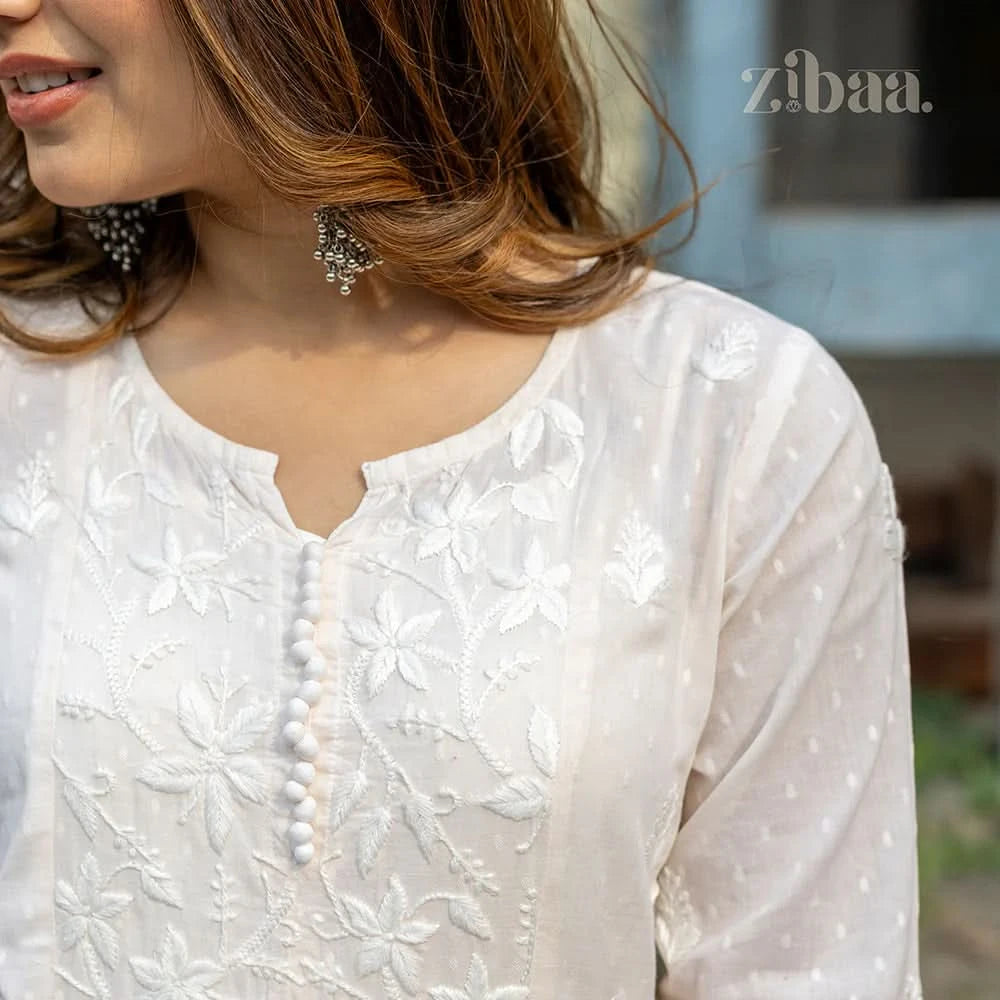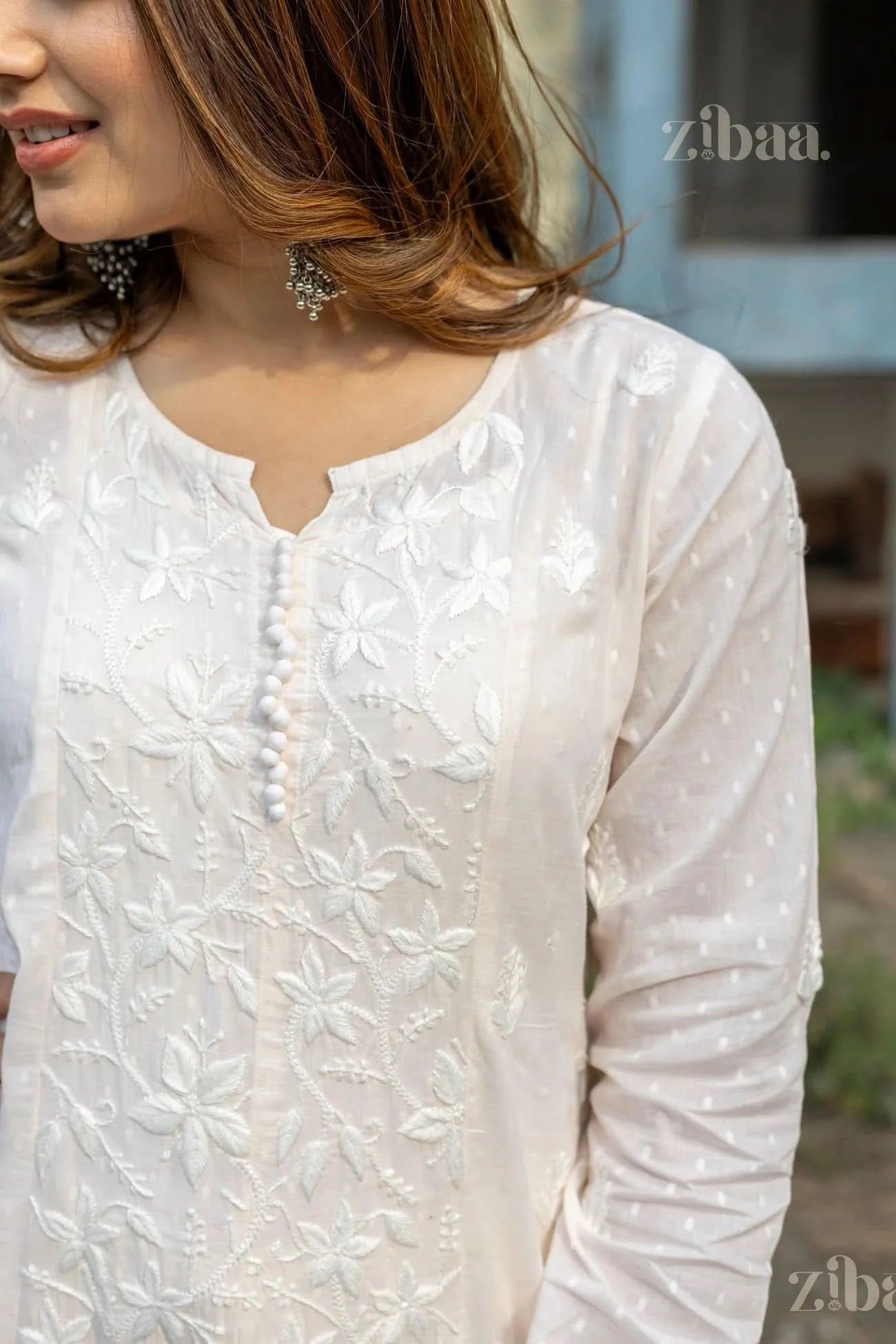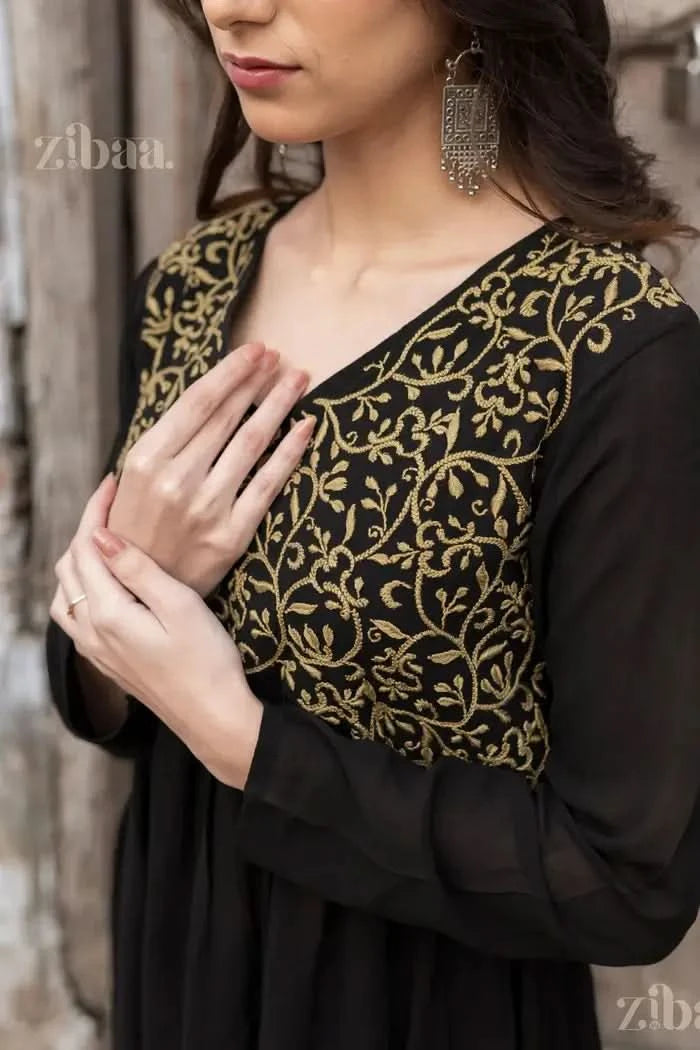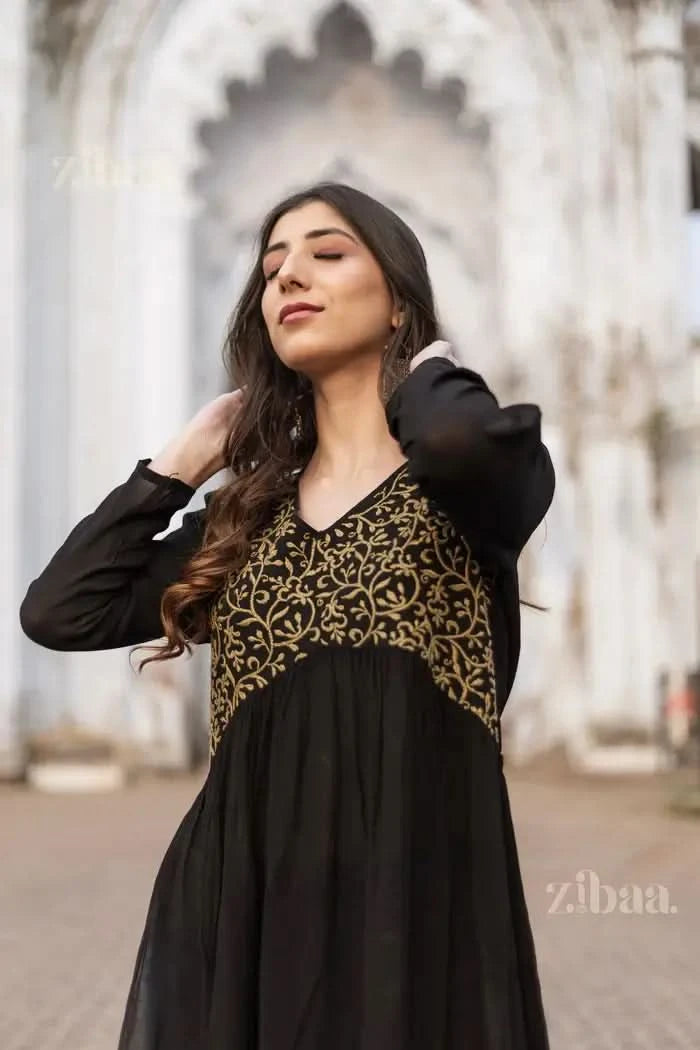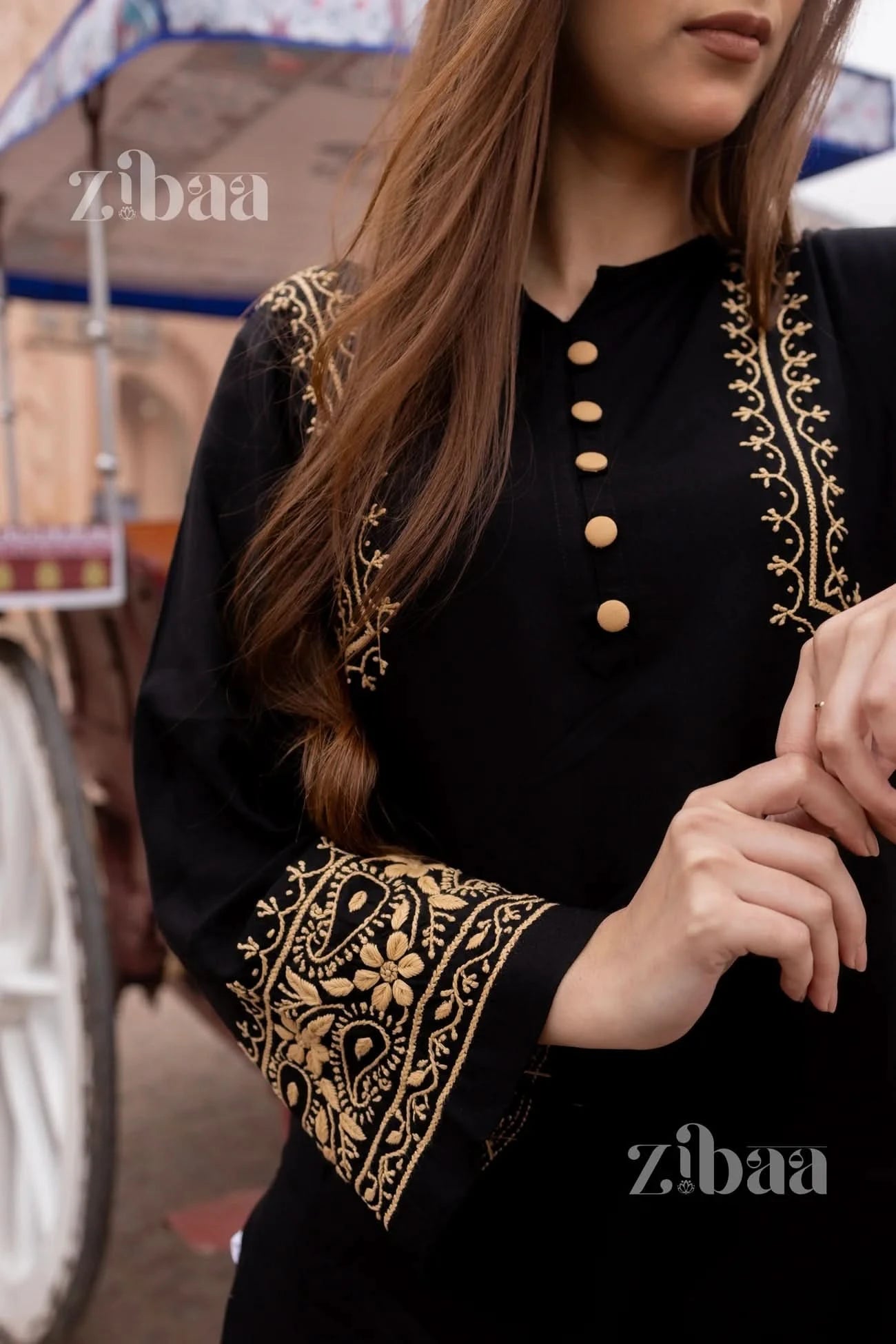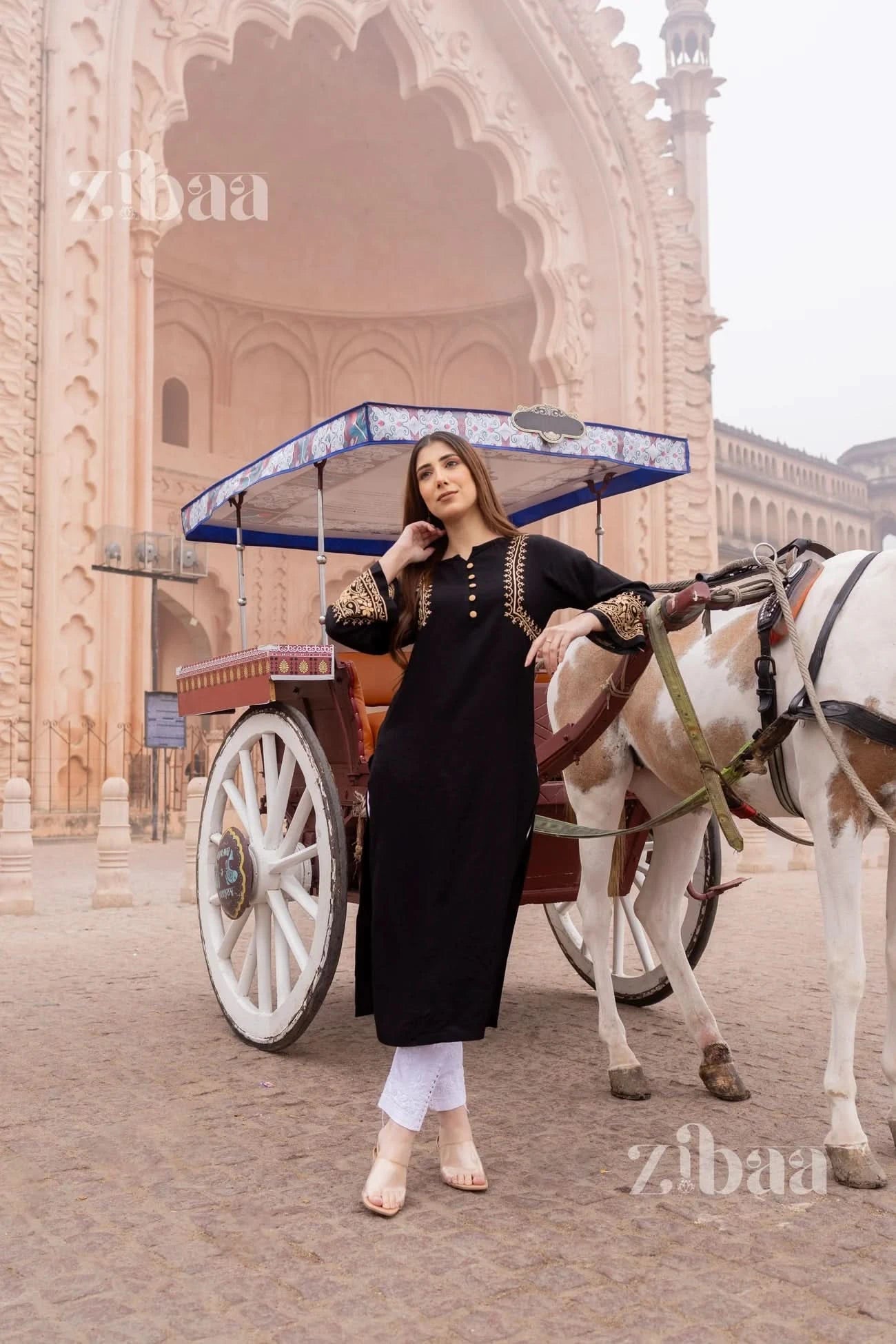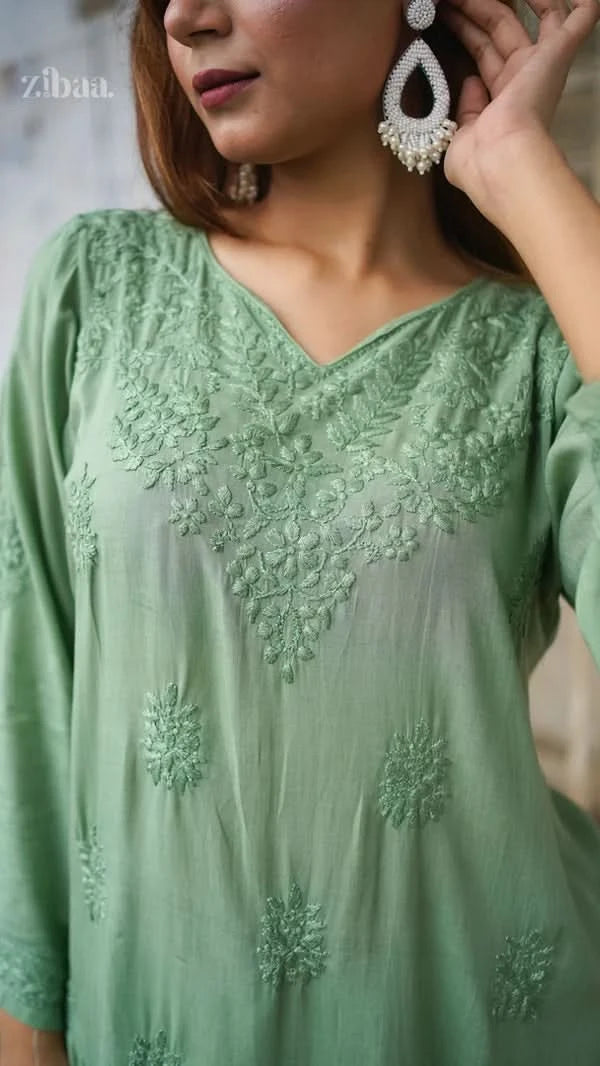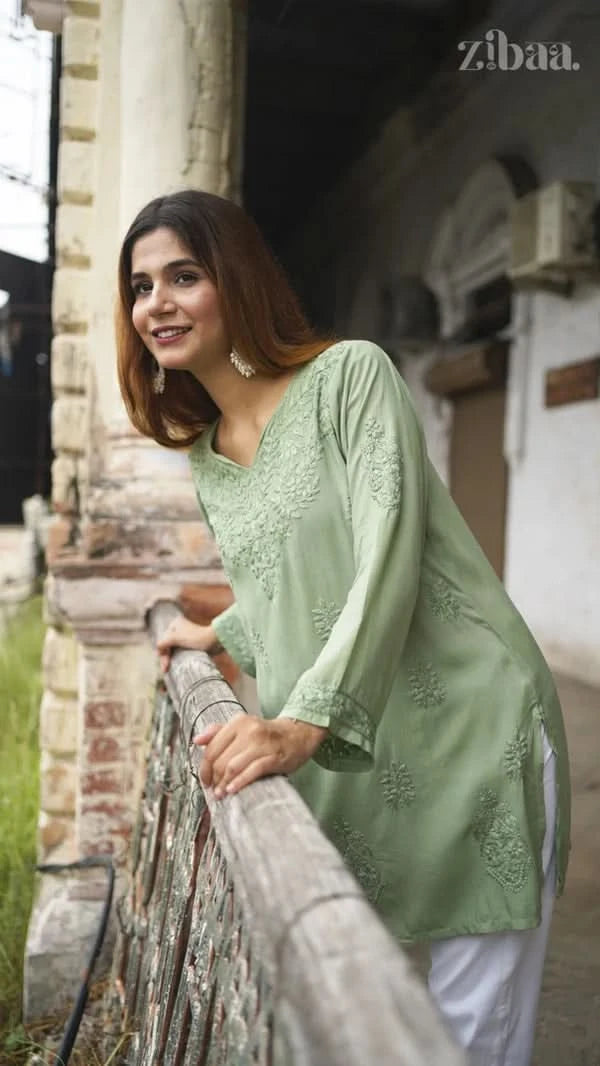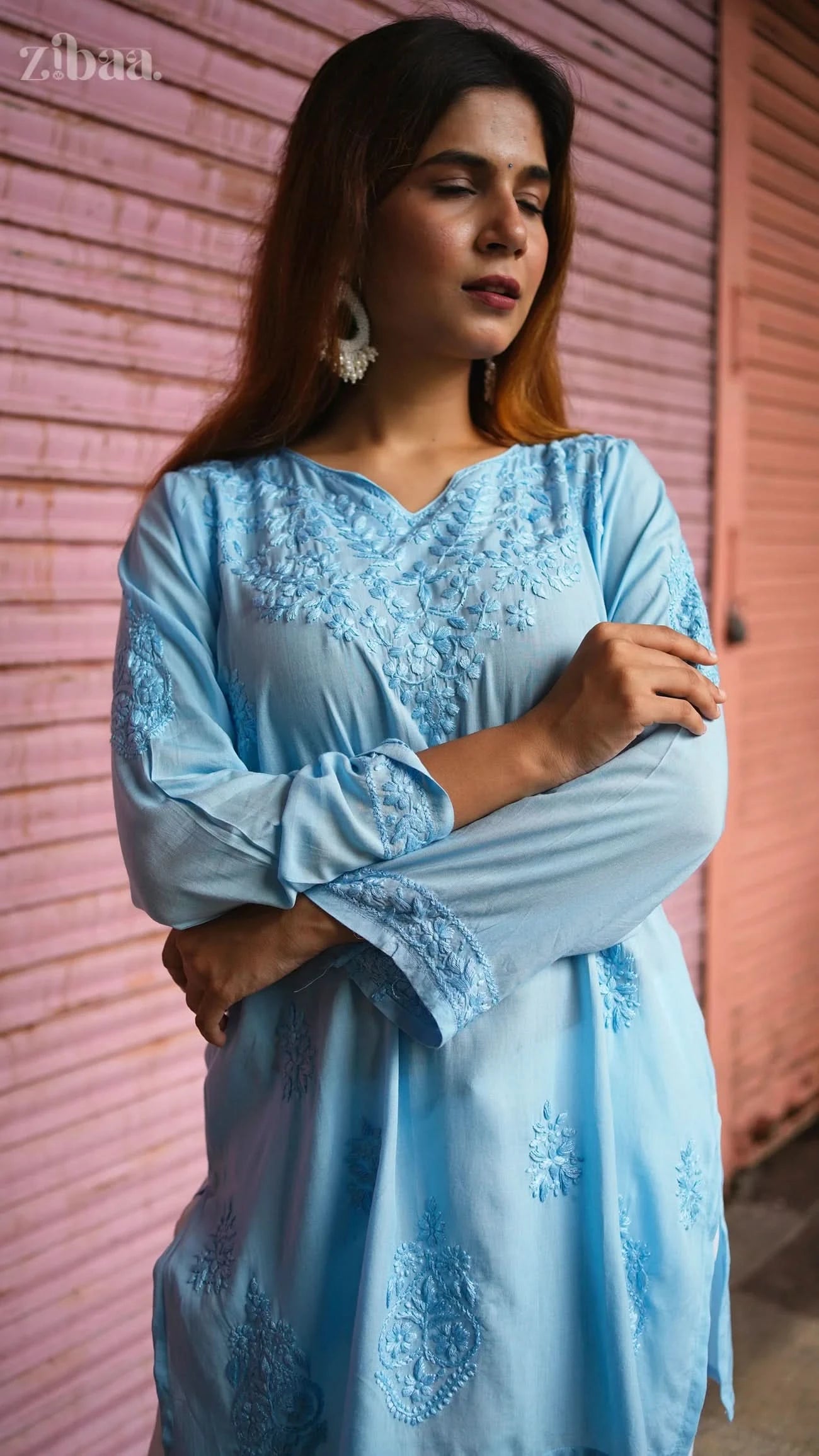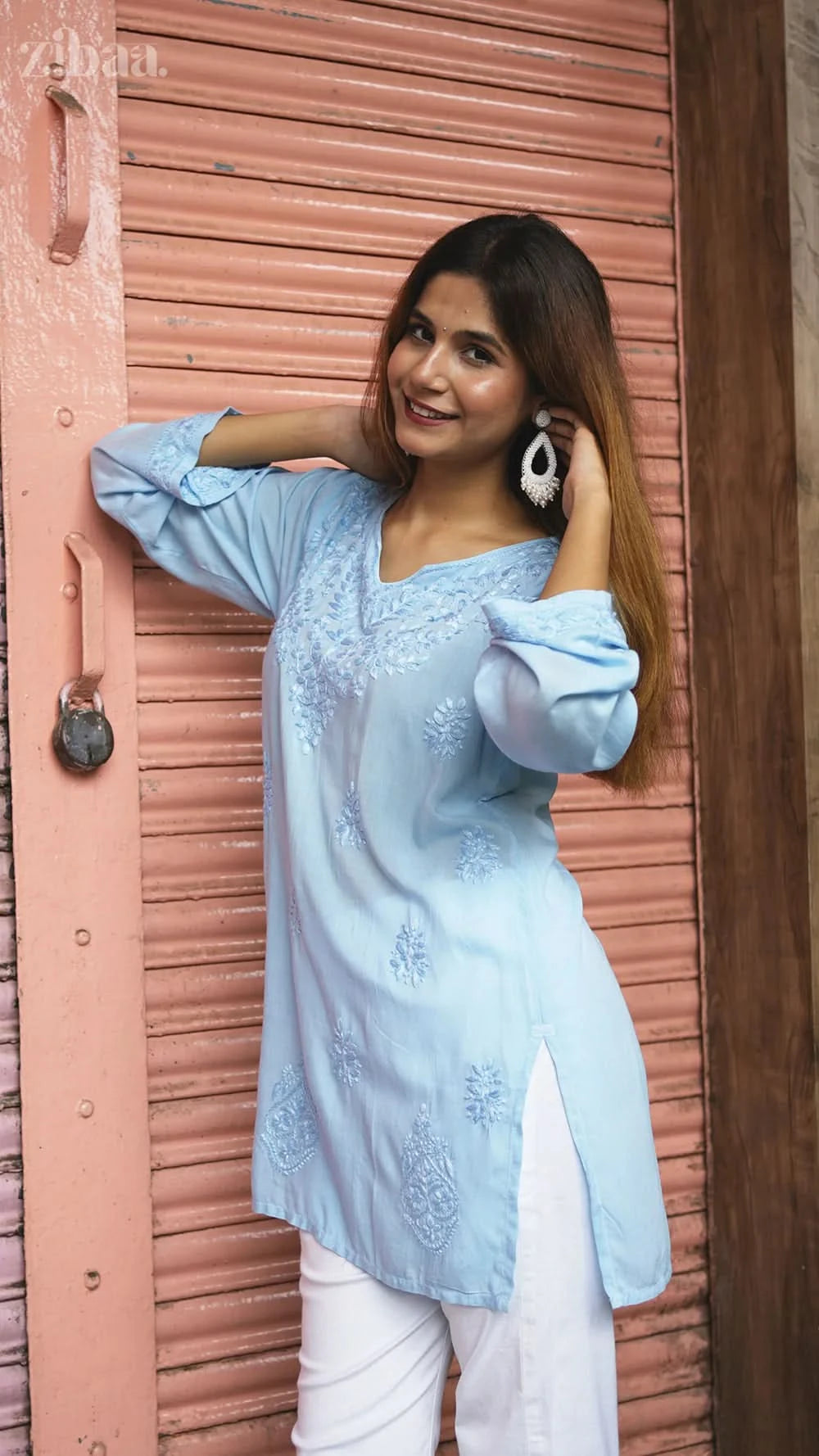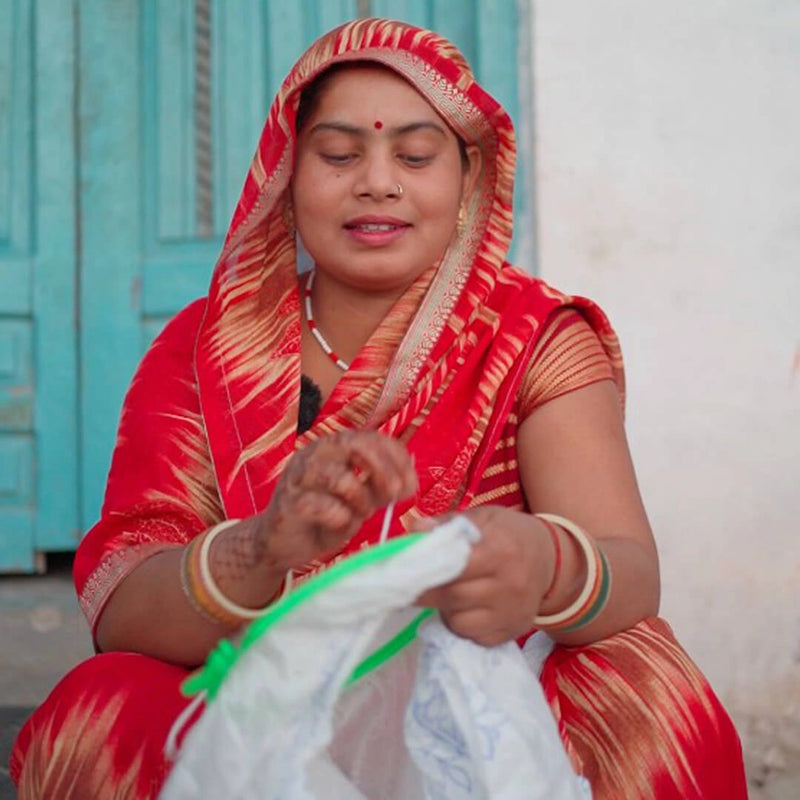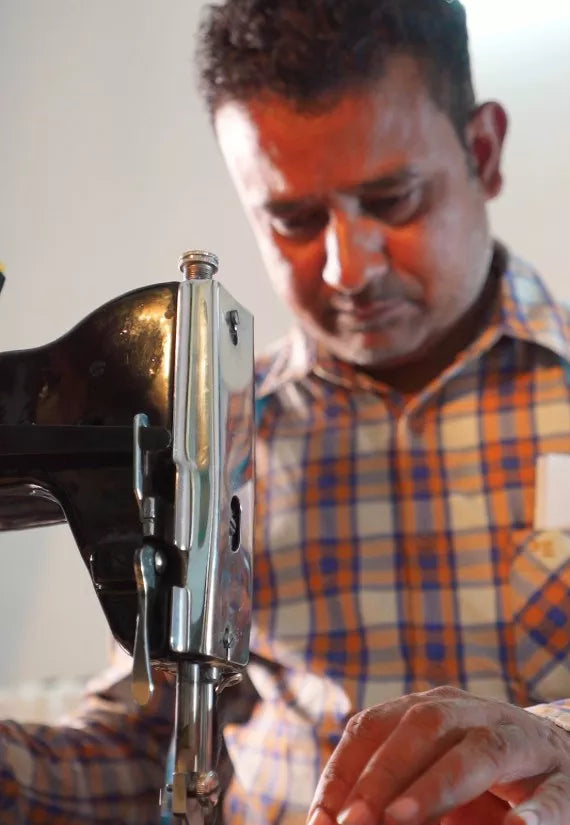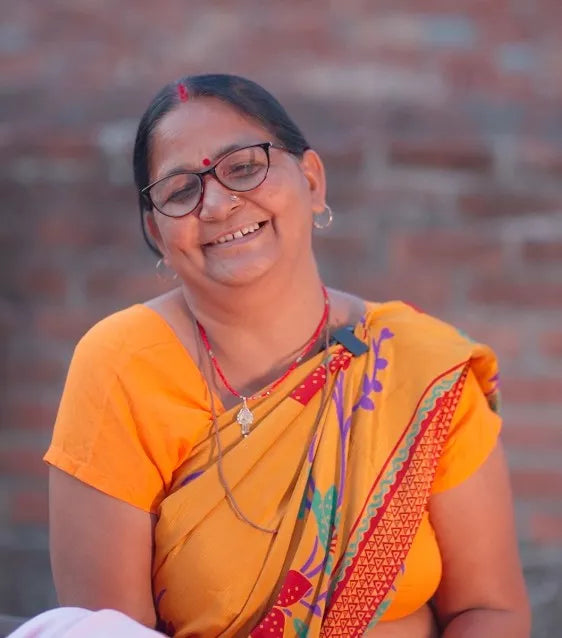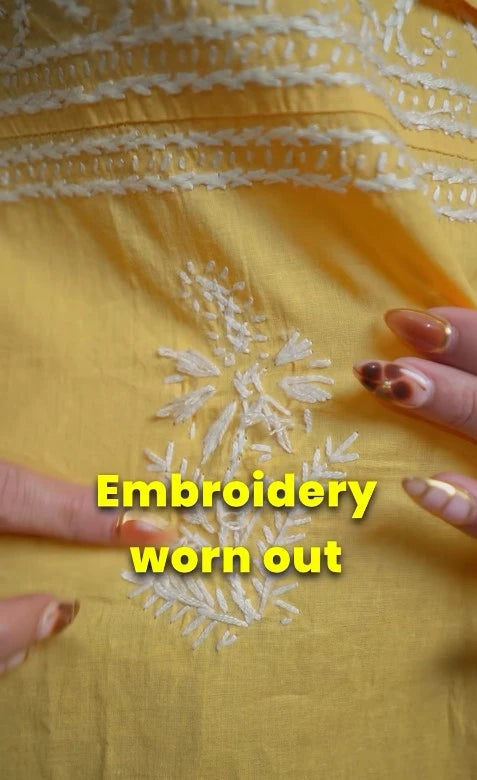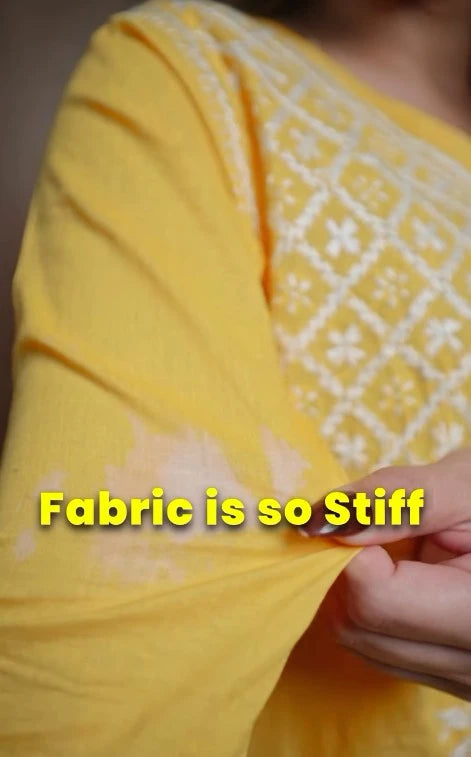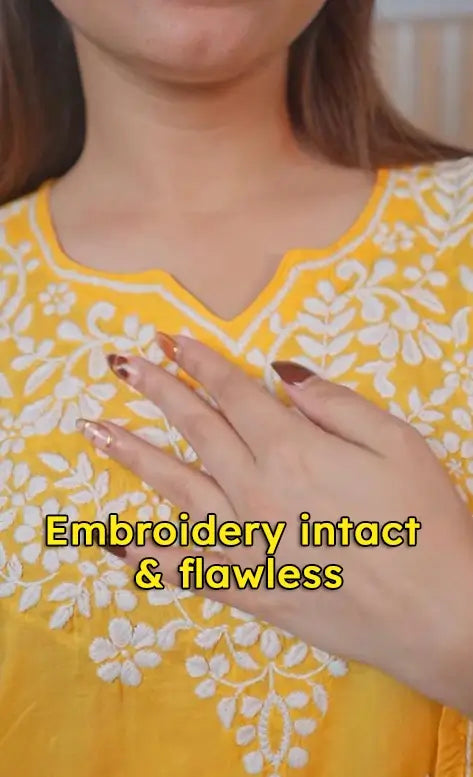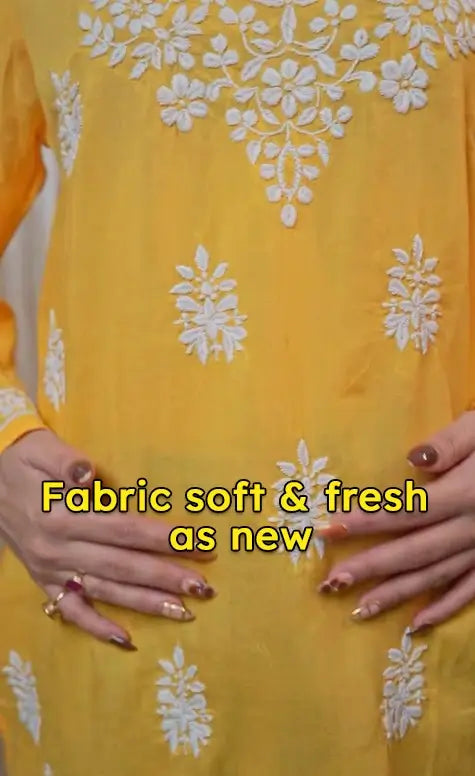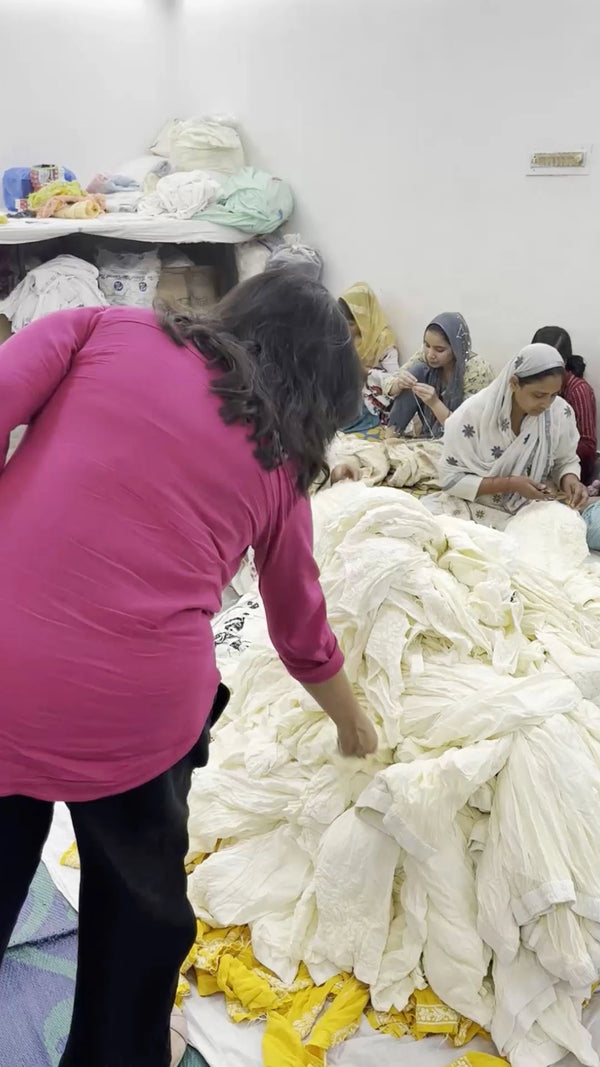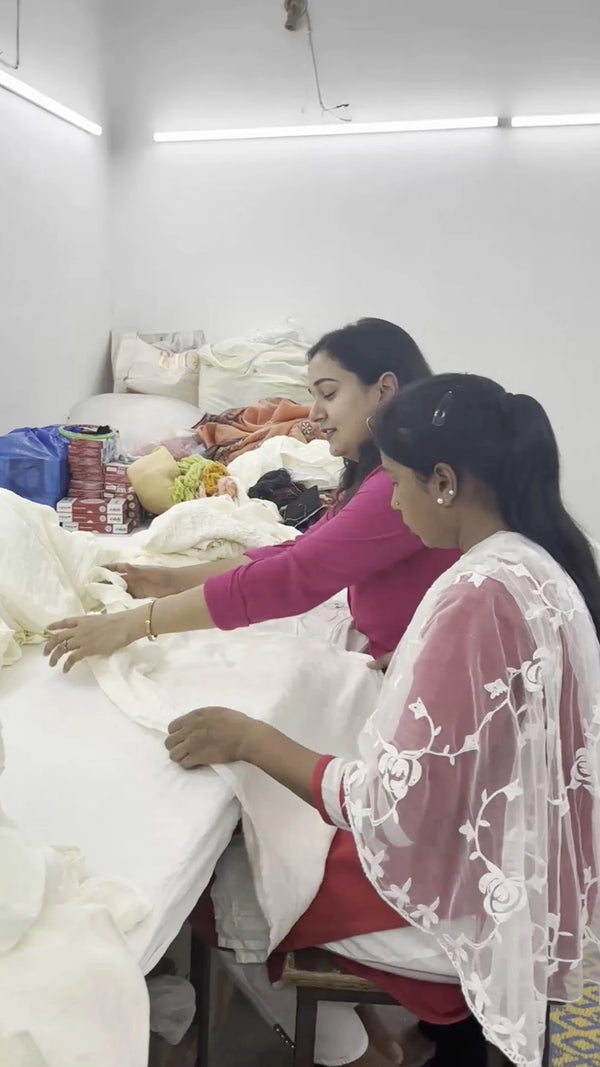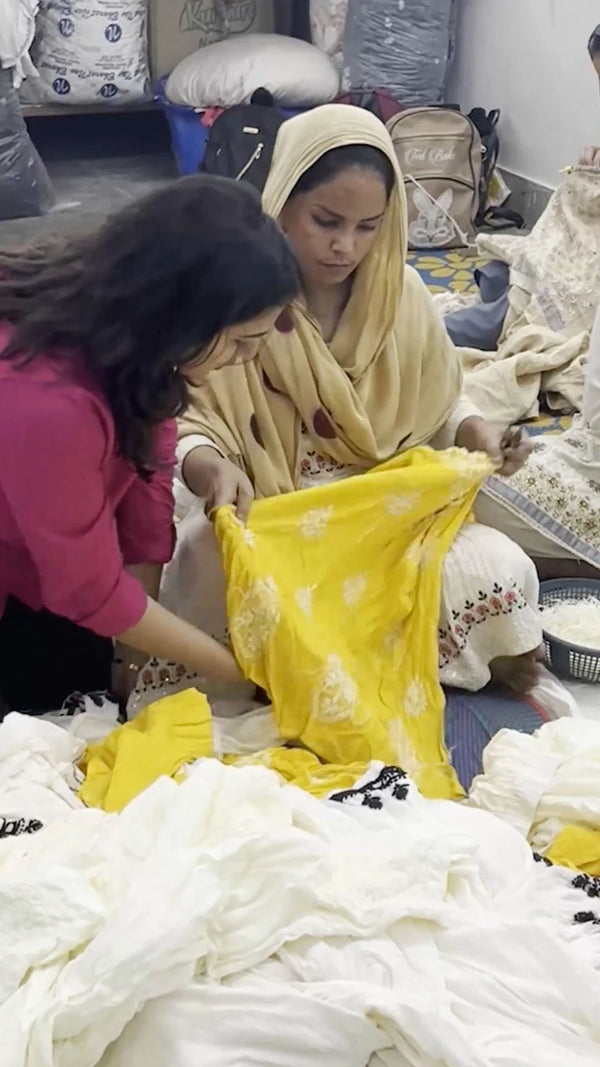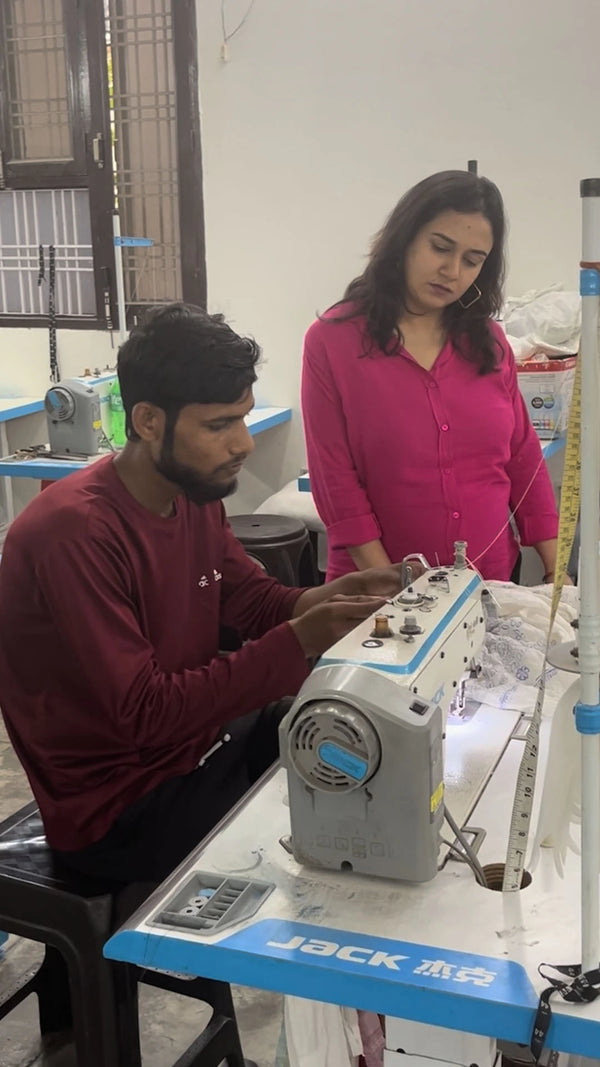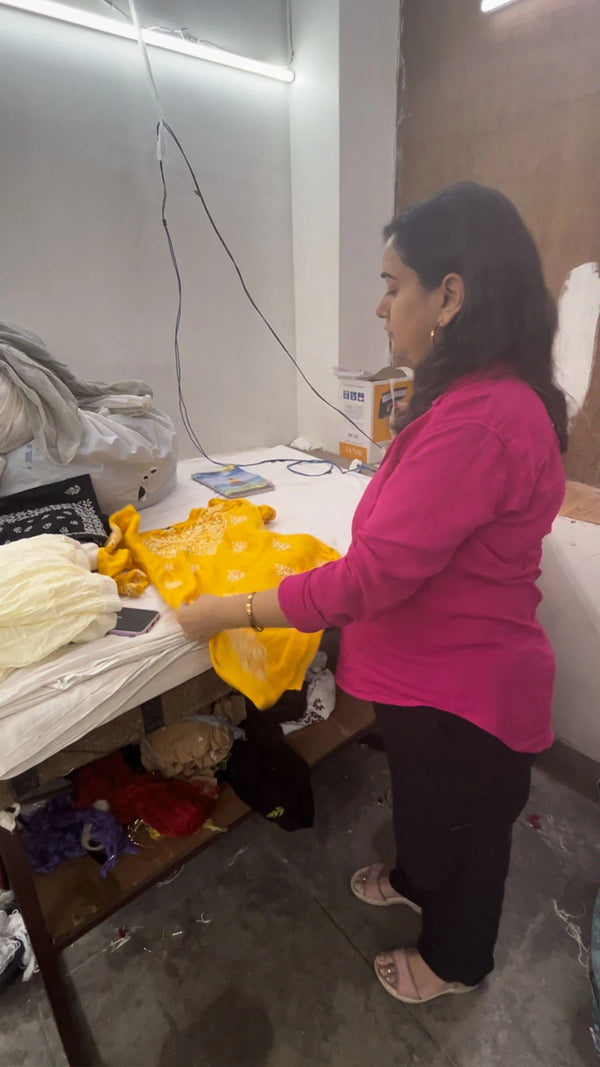Inception of Chikankari in India
The delicate and intricate art of Chikankari is one of India’s most famous hand embroidery styles. As the name suggests, it originated in Lucknow and adjoining areas of Uttar Pradesh. It is characterised by its white cotton or muslin base fabric, upon which white thread embroidery featuring floral, leafy, and other motifs is done. This white-on-white effect lends it a unique grace.
It is believed that this elegant embroidery came to India in the Mughal era. Historians think the earliest form of this stitchwork was influenced by Persian and Turkish needlework styles. Local Indian artisans adapted their techniques, giving birth to the Lucknowi Chikankari as we know it today.
-
The art was patronaged under the Awadh's Nawabs in the 18th century
-
It flourished under the support of nawabs and their courtiers, who wore embroidered angarkha tunics made of fine muslin and cotton
-
Skilled karigars (artisans) practised their art and continued to be sponsored by the royals
-
The cities of Lucknow, Barabanki, Hardoi and Sitapur became hubs
While men marked out the patterns on cloth, women artisans used spike bones to embroider them with delicate herringbone, running, and Holbein stitches. Their work required tremendous focus—some even used a hollow bamboo stick against the fabric to stabilise their hands.
The art form grew to be celebrated globally - it remains the only embroidery created on sheer fabrics like muslin.
From nawab's angarkhas, its use expanded into personal clothing like:
-
Chikankari kurtis with white or colourful dupattas for women
-
Anarkali suits and long modal dresses with chikankari yokes
-
Chikankari embroidery saris worn by brides as heirlooms
-
Ornate lehengas with all-over zardozi and chickankari
The growth of modern fashion has also led to the adoption of art work on fabrics like georgette, chiffon, and silk rather than just muslin. It is also being fused with other embroidery styles like zardozi, beads, mirrors, and tilla into contemporary bridalwear and occasionwear. Works are no longer defined by white-on-white—colourful threads are now being used to meet modern preferences.
However, the traditional embroidered kurta retains its classic appeal. It requires tremendous skill and labour intensiveness due to the delicate handling of fine threads and sheer base fabrics. Places like Lucknow continue to nurture skilled karigars who have practised the art for generations within artisan families. Their pursuit of chikankari makes it one of India’s most treasured hand-embroidery art forms. Though the designs and colours may evolve with time, the finesse of an authentic dress is unmatched!
Why This Timeless Embroidery Is Thriving in India Today
The exquisite hand embroidery art has seen a major revival in recent years. From a declining cottage craft, it has transformed into a flourishing industry associated with Indian craft heritage and textile luxury. Many key factors have enabled the phenomenal growth of the chikankari kurti for women on both national and global levels:
Revival Efforts: Concerted efforts by advocacy groups like the Uttar Pradesh government’s One District, One Product (ODOP) scheme have focused on nurturing karigars or artisans. Providing them with design and technical skills has helped Chikankari become competitive.
Online Ecommerce: A huge factor behind Chikankari’s booming popularity is the reach enabled by online retail platforms and websites. Sites like Amazon, Flipkart, Meesho and crafts platforms like Jaypore have taken signature pieces like tops, kurtis and tunics into countless wardrobes:
-
Thanks to greater accessibility, millions across India have discovered and embraced exquisite handcrafted embroidery.
-
Specialised virtual stores give good margins to sellers and weavers
-
Reviews and return policies have built customer trust
This table shows the rapid revenue growth from online sales:
|
Year
|
Online Revenue (In Crores)
|
Online Contribution (%)
|
Yearly Growth Rate (%)
|
|
2019
|
45
|
21.95%
|
13.89%
|
|
2020
|
70
|
31.11%
|
9.76%
|
|
2021
|
95
|
36.54%
|
15.56%
|
|
2022
|
125
|
41.67%
|
15.38%
|
|
2023
|
160
|
47.06%
|
13.33%
|
Fashion Trends: This beautiful form of embroidery has grown far beyond its traditional roots. Today, you can find it on everything from fusion dresses and crop tops to skirts and jackets. Designers are getting creative by pairing it with denim, using bold colors instead of the usual white, and blending it with block prints and other craft techniques. It feels fresh, fashionable, and right at home in modern wardrobes. Many brands now release seasonal collections that combine old world charm with new age style. This revival is not only bringing attention to the craft but also creating real support and income for the artisans who have kept it alive for generations.
Top Indian Cities Driving Demand for Chikankari Art
1. Lucknow – The Home of the art form
Lucknow, where this two hundred-year-old embroidery began, remains the center for artisans and production. Most skilled craftspeople come from villages around the city. Shops in Lucknow offer the widest range of long embroidered kurtis, serving both locals and visitors alike.
2. Delhi NCR – Big Market for Apparel
Delhi NCR is the national capital region with a large, fashion-conscious population and good purchasing capacity. Many designers sell stylish Chikankari short kurti here through studios and online stores. From modish crop tops to fusion sarees, Delhi’s dynamic market has demand for innovative styles beyond the classic kurtas and salwar suits.
3. Mumbai – India’s Fashion Capital
Mumbai city signifies style - Bollywood glamour, fashion designers and media highlight the latest trends. The climatic warmth also makes light, breathable fabrics more suitable. Flowy yellow kurta embellished using diverse embroidery techniques resonate well with young working women and collegegoers here.
4. Kolkata - Traditional Apparel Market
People in Bengal have a strong appreciation for traditional designs, especially those featuring detailed needlework. As a result, Kolkata has a consistent demand for various types of intricate embroidery, including reshma and zardozi styles, along with white thread handiwork. The popular choices tend to be classic patterned sarees, elaborate bridal lehengas, and traditional salwar kameez outfits rather than Western-style clothing.
Revenue Growth of Chikankari in India Over the Last Five Years
The beautiful and intricate white embroidery on fabrics like muslin, silk, and cotton has grown hugely popular over the past five years. This delicate craft is a source of pride for India, but mastering it takes great skill and time. Because of the effort involved, hand-embroidered clothes used to be costly and were mostly reserved for weddings and festivals.
But between 2017 and 2021, a lot of things changed for the good of this craft. Firstly, many Indian celebrities and politicians chose ethnic Chikankari kurtas and sarees for important events. A lot of common people were inspired to buy similar outfits because of this. Photos and videos spread fast on social media, which increased the buzz.
Secondly, the Indian government offered special training and small business loans, which helped more people learn this art and set up their labels. Moreover, the young girls and boys in small towns got employment closer to home, and their families could earn more income because of the rising demand.
Lastly, online shopping websites and apps made it possible for small-town sellers to access buyers across India. With that being said, the customers from cities could also place customised orders and pay digitally.
This table shows the rapid revenue growth from online sales:
|
Year
|
Online Revenue (In Crores)
|
Online Contribution (%)
|
Yearly Growth Rate (%)
|
|
2019
|
45
|
21.95%
|
13.89%
|
|
2020
|
70
|
31.11%
|
9.76%
|
|
2021
|
95
|
36.54%
|
15.56%
|
|
2022
|
125
|
41.67%
|
15.38%
|
|
2023
|
160
|
47.06%
|
13.33%
|
An Overview of Chikankari Kurti
This delicate embroidered kurti is one of the most beloved traditional garments. It’s a short collarless shirt or tunic worn by women across India.
Fabric: Traditionally done on soft muslin or cotton fabrics, the detailed work now extends to flowy georgette, chiffon and silks for a contemporary touch. While white on white looks classic, pastel colours like lemon yellow, pink and beige are also used.
Silhouette: Straight fit Anarkali Kurtis, calf-length tops with side slits, short round embellished kurtis – all styles are common as per changing trends. The royals historically favoured work-intensive flared kurtas.
Embroidery: Delicate threadwork using chain, Bakhiya, and jaali stitches lends ornamentation without overpowering the base fabric. Motifs are classically floral, like roses, leaves, creepers, and kalga motifs. Modern variations also feature paisleys, birds, geometric prints, etc.
Necklines: The most common necklines, including round, square, V-shaped, boat, and mandarin necklines, are beautifully offset with distinct stitches on the yoke. Some kurtas may have lace or embroidered panels.
Sleeves: Full, 3/4th, short, puffed, frilled, or cap sleeves suit the embroidered composition on Kurtis.
Colourways: Soft fabrics suit white, pastels like blush pink, lemon yellow, or beige shades. Darker hues like black, red, blue, or green kurtas also make bold statements when worked on matte silk or cotton.
Pairing it with slim-fit churidars, leggings, or skirts complements the kurti’s flare. Gossamer dupattas can lift the look for occasions. Chikankari embroidered kurta, hence, are versatile Indian ethnic wear, suitable for daily wear as well as wedding wear, and are made of cooling, breathable fabrics.
The Intricate Process Behind Making a Chikankari Kurta
1. Fabric Selection
The base fabric is vital to sustaining the fine embroidery. Traditionally, soft, sheer, and lightweight Indian muslins like tanchoi, mulmul, or malmal were used so that the intricate needlework was clearly visible. Now, even fabrics like cotton, voile, cambric, silk, or handloom are chosen to design kurtas and suits.
2. Pattern Making
Earlier, the main designer would guide the pattern master or naqash in drawing out the figured motifs to be embroidered on paper. Today, computerised design software is also used along with hand-drawn crafts. Floral vines, leaves, blooms, kalga, concentric circles, etc., are most commonly seen.
3. Block Stamping
The patterns are then perforated along the marked outlines using tiny spikes. These perforated motif outlines are manually directly stamped onto the fabric using wood blocks etched with tiny metal pins. Skilful blocking masters transfer the patterns accurately onto yards of the base fabric.
4. Embroidery Stitching
Once the motif blocks are stamped, clusters of highly skilled women artisans begin the painstaking hand embroidery involving special stitches like taichi, pika, panda, murri and more. No knots are used - only alternating reverse stitches in perfectly uniform tension with fine white thread. Tiny “kasheeda” needles pierced into the fabric follow marked patterns to create ornamented white-on-white designs.
5. Washing
Once initial work is complete on marked fabrics, they are mildly bleached to enhance the white-on-white effect. The fabric is then washed to remove block imprint outlines, and light starches are sometimes applied to it to stiffen it.
6. Cutting and Stitching
The base fabric yardage is then cut and tailored into kurta silhouettes or salwar suits as per patterns. Trendy fits, necklines and sleeve styles are used for modern garments. Side slits, gathers or frills may be part of the style vision.
7. Accessory Embellishing
Some designer embroidered kurtas include extra details like handwoven trims, delicate mirror work, sequins, or beads on the yoke, sleeves, or hemlines. These additions give the garment a festive feel while keeping the traditional embroidery’s true essence intact.
8. Finishing
The final stages involve cleaning, pressing, and finishing. Each perfectly crafted garment goes through multiple quality inspections before leaving for the stores. Though production happens locally, signature pieces travel far across India and overseas, too!
So, the end-to-end making of chikankari short kurti requires almost 10-12 skilled hands working in harmony to translate the designer's vision into bespoke pieces. Their collective family wisdom, individual acumen, and tireless enterprise transform plain fabric into an exquisite ensemble within weeks.
Stitches Used in Chikankari Tops
|
S.No
|
Stitch Name
|
Overview
|
|
1.
|
Flat Stitches
|
The most basic stitch in Chikankari embroidered kurta is the flat stitch. It comprises simple, tiny running stitches sewn evenly using untwisted white thread. Flat stitches outline the main shapes and motifs, such as leaves, petals, or filler patterns.
|
|
2.
|
Banarsi Stitch
|
The Banarsi stitch gets its name from the famous silk weaving region - Varanasi. In Chikankari embroidery on kurtas and dupattas, the Banarsi stitch uses very fine straight stitches cleverly interlocked to form gorgeous textures.
|
|
3.
|
Bhakhiya
|
Bhakhiya refers to the lattice work created on garments using this clever stitch. Straight or diagonally placed stitches are spaced and interlocked evenly with crisscrossing threads at regular intervals. This gives rise to a net-like jaali effect perfectly aligned over marked patterns.
|
|
4.
|
Bijli
|
As the name suggests, the Bijli stitch resembles lightning on Chikankari kurta pieces. Delicate yet visually striking, small zig-zag running stitches are better suited to define the contours of floral and leafy patterns or sprigs.
|
|
5.
|
Couched Running Stitch
|
The visible white thread is anchored in a couched stitch using invisible laid work with a sturdy, darker cotton thread on the reverse. The supporting thread is often made to peek and mingle through for accent.
|
|
6.
|
Fishbone Stitch
|
Fishbone stitch in intricate Chikankari involves two parallel rows of crisscrossed straight stitches that merge partway to mimic the ridged appearance of a fish skeleton.
|
|
7.
|
Hathkati Stitch
|
An ingenious technique called Hathkati or cutwork precedes actual embroidery in certain heirloom lehengas or bridal sarees. It involves precision layering and attaching cloth pieces before they are ornamented with white stitchwork.
|
|
8.
|
Jali Work
|
Jaliwork involves leaving intentional holes amid portions of white stitch embroidery to lend a lacy, perforated effect.
|
|
9.
|
Kangan Stitch
|
A thick specialty satin stitch variant spaced using straight spikes to resemble a sequence of bangles or kangans, this is eye-catching on bridalwear necklines.
|
|
10.
|
Murri Stitch
|
Murri stitch forms the base for further exquisite needlecraft in Lucknowi Chikankari. To do Murri work, artisans delicately arrange rows of untwisted fine white threads side by side so there are no visible gaps between them.
|
Which fabrics work best for embroidered kurtis?
Choosing the right fabric is essential to highlight the beautiful patterns created with delicate stitches. Here are the best materials for embroidered kurtas and tops:
Cotton Fabrics
-
Soft muslins like Dhaka mulmul, tanchoi and malmal finely woven using high quality cotton threads are traditionally used. Their sheerness helps clearly see through to minute embroidery details.
-
Premium cotton fabrics like cambric, voile, and organic materials beautifully maintain the shape and flow of these garments, creating elegant drapes.
-
Pastel shades also suit classic white embroidery well instead of stark whites.
Chiffon
-
Chiffon with its gossamer finish creates a stunning canvas for ornate floral embroidery, perfect for sarees and evening gowns. The delicate fabric pairs beautifully with fine, detailed needlework.
-
Its translucency spotlights all jaali, pechni and other embroidery elements along with their shadow work illusions.
-
Hues like powder blue, pink and lemon yellow chiffon beautifully offset white stitching.
Georgette
-
Georgette is perfect for flowy crop tops. Being slightly textured and shear, machine-printed motifs likely integrate better than handwork, which demands more drape.
-
Kurtis in pastel georgette with sparsely placed embroidery is a huge market favourite because they combine comfort, fall, and embellishment.
Khadi Fabrics
-
Superfine Khadi handloom cotton's signature textured look also prominently supports the craftsmanship. The fabric gives body yet porosity for the needles.
-
Designers often use brown, black or green khadi kurtas to allow brighter white stitch pop for fusion pieces.
Silk
Which colors are trending this summer for traditional embroidered tops?
1. Serene Blue Kurta
The top color this summer for embroidered kurtis is calm shades of blue. A powder blue kurta with delicate white jaali embroidery all over creates an effortlessly stylish look for daytime. The soft pastel shade combined with light, intricate needlework lets air flow freely, making it perfect for comfortable summer office wear.
2. Vibrant Yellow Chikankari Kurta
Yellow is traditionally associated with auspiciousness in Indian culture, making it perfect for summer's cheer. A crisp lemon yellow Chikankari cotton kurta with minimal white stitch accents makes a happy daytime choice.
3. Calming Green Chikankari Kurta
Another timeless summer color, green offers a calming background for delicate white embroidery details, especially since many designs feature leaves and vines. For eco-friendly occasions, wearing forest green Khadi linen kurtis with embroidered accents on the pockets creates a fresh and stylish look.
For those looking to go beyond traditional pastels, black is a chic choice for an evening kurta. Pairing a black embroidered kurta with slim white salwars creates a stylish and unexpected look perfect for cocktail parties or receptions..
5. Pink Chikankari Kurta
Pink spells indulgent femininity and is super vogue in Indian festive wear. Chikankari embroidery detailing paired with gold zardozi and sequins along the placket of a fuchsia anarkali kurta also makes a glamorously laidback option for mehendi nights or roka ceremonies.
5 Ways to Style Chikankari Kurti
1. Pair with Palazzo Pants
Palazzo pants look gorgeous when paired with the kurtis. The flair of the pants complements the flair of the kurta beautifully. You can opt for flowy palazzos made of silk or chiffon in a solid colour like turquoise blue, pink or maroon to match a Lucknowi Kurti.
2. Combine with Skinny Jeans
One stylish way to wear embroidered kurtis is by pairing them with skinny jeans. This adds a modern twist to traditional attire. For instance, a crisp white cotton kurti with delicate leafy embroidery along the neckline looks great with well-fitted dark blue denim jeans. This easy combination is perfect for casual daytime outings with friends.
3. Accessorise with Statement Jewellery
You can beautifully elevate traditional long Chikankari kurtas ornamented with delicate threadwork by pairing them with eye-catching jewellery pieces like waist belts, long necklaces, and chunky bracelets. Go for classic Polki and Kundan sets with colourful stones, pearls, and beads to contrast with the subtle white-on-white subtle embroidery of your pastel yellow or pink kurta and salwar.
4. Layer with Denim Jackets
If you want to give your everyday embroidered tops a laid-back feel, try layering them with colorful casual denim jackets for a cool, informal fusion look. Denim trucker jackets add a free-spirited, Indo-western vibe, while the flowy volume of long, flared beige tops underneath keeps it stylish and street-ready.
5. Pair with Long Flowy Skirts
To create dreamy ethnic ensembles for occasions, beautifully team prestigious Chikankari kurtas embellished using intricate stitches and patterns with subtly coloured flowy long skirts. The floaty cut will complement the luxurious needlework on the necklines, yokes, and sleeves of your kurta.
Why Bollywood Can’t Get Enough of This Timeless Embroidery
The delicate beauty of Lucknowi embroidery has adorned Bollywood divas onscreen in many memorable movies. Its artisanal allure aptly complements Indian ethnic fashion depicted in films.
Jab We Met
Kareena Kapoor Khan portrayed the effervescent Geet in a brightly hued short kurti with dense Chikankari trims along the neck, hem, and cuffs in cheerful marigold yellow. This well depicted her lively small-town girl character.
Raazi
Alia Bhatt looked picture perfect in elegant Chikankari kurtis as the simple yet brave Sehmat in Raazi, set in the 1970s backdrop. She was seen in fine pastel-hued cotton and muslin kurtas ornamented with intricate threadwork to bring out old-world charm. The neutral kurtis aided her character's disguises during spy missions by blending in easily.
Guru
Aishwarya Rai Bachchan portrayed the role of Sujata in the period drama Guru, wearing breezy printed mulmul kurtas highlighted with sparse yet striking opaque zardozi and Chikankari accents. The subtle embroidery balanced the relaxed silhouettes mirroring the 1950s middle class aesthetics.
Kalank
Madhuri Dixit Nene was seen gracefully draped in rich Varanasi silk langa varkali sets featuring intricately crafted motifs scattered across the yoke and sleeves in the song 'Tabah Ho Gaye'. The embroidered ensemble complimented her graceful dance moves during the mujra performance.
Bajirao Mastani
Deepika Padukone was embellished in a scene wearing an ornate peach Chikankari angarkha worn over champagne pink Raw silk salwars featuring all over bootis as Mastani showcasing the fine nawabi influence.
So, from small-town girl next door looks to aristocratic royalty, This timeless embroidery has found its way into iconic film costumes, with designers tailoring each look to reflect a character’s story and add depth to the visual narrative. Our Bollywood divas shine even brighter when dressed in these revived textile treasures that celebrate India’s rich craft heritage.


